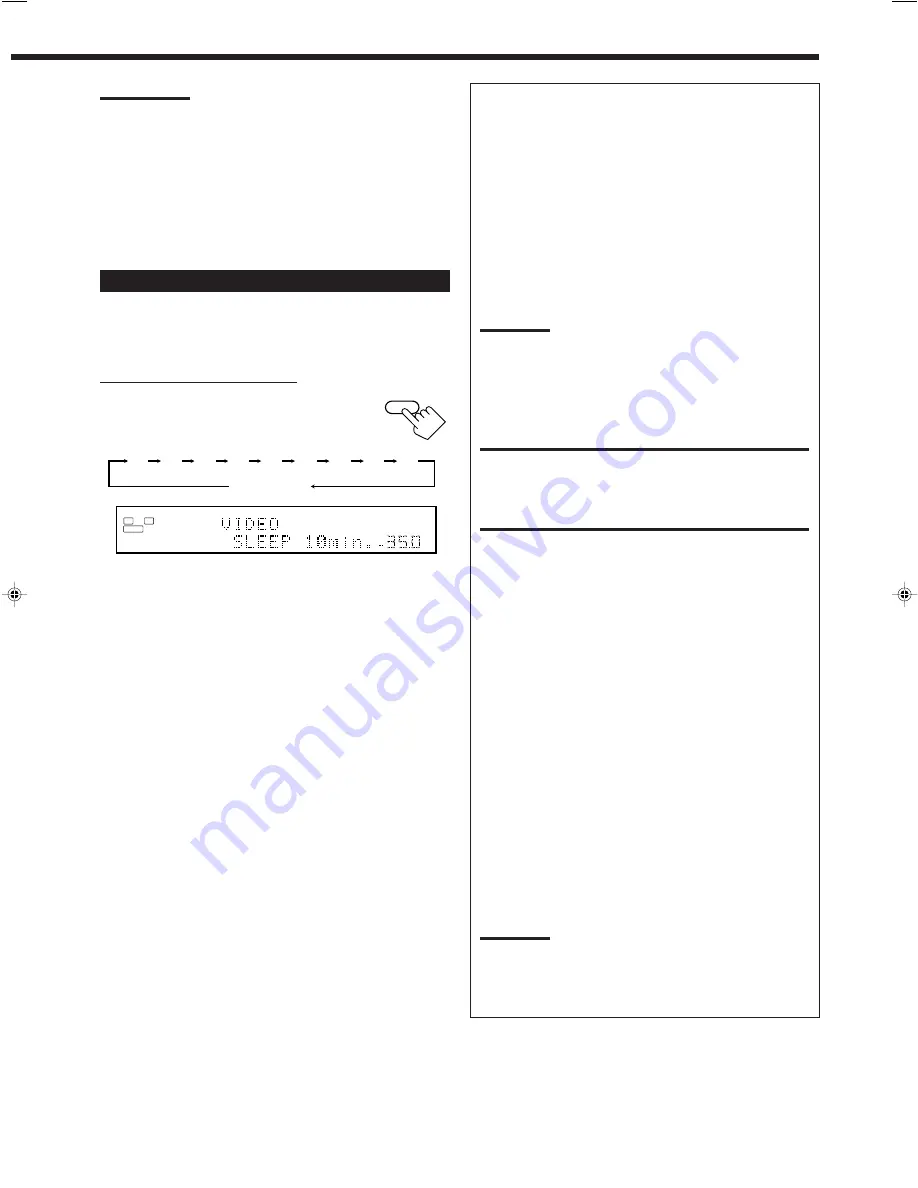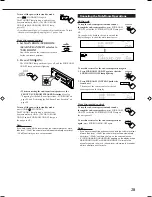
26
Notes:
• Once you change the source name, it is applied both for the main
room source and sub-room source.
• Without changing the source name, you can still use the connected
components. However, there may be some inconvenience.
– “TAPE” or “TV” will appear on the display when you select the
MD recorder or DBS tuner.
– You cannot use the digital input (see page 23) for the MD
recorder.
– You cannot use the COMPU LINK remote control system (see
page 54) to operate the MD recorder.
Using the Sleep Timer
Using the Sleep Timer, you can fall asleep to music and know the
receiver will turn off by itself rather than play all night.
• The Sleep Timer works for the main room source only.
From the remote control ONLY:
Press SLEEP repeatedly.
The SLEEP indicator lights up on the display, and the
shut-off time changes as follows (in minutes):
When the shut-off time comes
The receiver turns off automatically.
• If the sub-room source is still played (the SUB ROOM ON/OFF
lamp is lit) when the shut-off time comes, the receiver will not
turn off, but only the main room source will shut off.
To check or change the time remaining until the shut-off time
Press SLEEP once.
The remaining time until the shut-off time appears in minutes.
• To change the shut-off time, press SLEEP repeatedly.
To cancel the Sleep Timer
Press SLEEP repeatedly until “SLEEP 00min.” appears on the
display. (The SLEEP indicator goes off.)
• Turning off the power also cancels the Sleep Timer.
Recording a Source
For analog-to-analog recording
You can record any analog source through the receiver to—
• the cassette deck (or MD recorder) connected to the TAPE/
MD jacks,
• the VCRs connected to the VCR 1 and VCR 2 jacks, and
• the CD recorder connected to the CDR jacks
— at the same time.
For digital-to-digital recording
You can record the currently selected digital input source
through the receiver to a digital recording device connected to
the DIGITAL OUT terminal.
Notes:
• Analog-to-digital and digital-to-analog recordings are not
possible.
• All sound adjustments cannot affect the recording.
• The test tone signal (see pages 44, 49) does not come out
through the DIGITAL OUT terminal.
IMPORTANT:
• While recording, do not turn off the receiver or main room
source; otherwise, recording will stop.
• If the same source is selected both for the main room and the
sub-room, operating the sub-room source will affect the
recording.
Basic adjustment auto memory
This receiver memorizes sound settings for each source—
• when you turn off the power,
• when you change the source,
• when you change the analog/digital input mode (see page 23),
and
• when you turn on One Touch Operation (see page 40).
When you change the source, the memorized settings for the
newly selected source are automatically recalled.
The following can be stored for each source:
• Analog/digital input mode (see page 23)
• Input attenuator mode (see page 24)
• Line Direct (see page 25)
• Midnight mode (see page 38)
• Speaker channel output levels (see page 44)
• Parametric Equalizer setting (see page 44)
• DSP Parameters (see page 45)
• THX Surround On/Off setting (see page 48)
• Surround mode On/Off setting (see page 48)
• DSP mode selection (see page 52)
Notes:
• If the source is FM or AM, you can assign a different setting for
each band.
• If you want to memorize the volume level together with the
above setting, set “ONE TOUCH OPERATION” to “ON” (see
page 40).
SLEEP
20
10
30
40
50
60
70
80
90
(Canceled)
00
L
ANALOG
SLEEP
SPEAKERS
VOLUME
1
SUBWFR
R
dB
Ex. When the source is “VIDEO.”
EN17-30_RX-DP10VBK[J]_f
01.6.19, 1:13 PM
26
















































